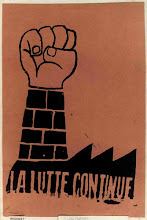 By NAZILA FATHI
By NAZILA FATHIPublished: January 20, 2008
TEHRAN — In early December, a surprising scene unfolded at Tehran University: 500 Marxist students held aloft portraits of Che Guevara to protest President Mahmoud Ahmadinejad’s policies. Smaller groups of Marxist students held similar protests in several other cities.
Political protest has been harshly suppressed under the current Iranian government, especially dissent linked to the West. But the radical left, despite its antireligious and antigovernment message, has been permitted relative freedom. This may be, analysts say, because, like the government, it rejects the liberal reform movement and attacks the West.
“The government practically permitted the left to operate starting five years ago so that they would confront religious liberals,” said Saeed Leylaz, a political analyst in Tehran. “But that led to the spread of a new virus.”
In recent weeks, the leaders of the Marxist student movement have been arrested, suggesting that the government is worrying about the size of the demonstrations and the growing attraction of an ideology that is deeply antithetical to its own.
Morad Saghafi, a political analyst and the editor in chief of Goftegoo magazine, said that it was not so strange that there were leftists but that it was significant that they were radical leftists.
“They are showing a kind of radicalism to reform, religion and the current situation,” he said.
Even some of those who object to President Ahmadinejad say permitting the growth of Marxist student movements is dangerous.
For example, former President Mohammad Khatami, a moderate by Iranian standards, recently raised concern over the growth of leftists at universities. He drew a comparison with the struggles before the 1979 revolution and said after the shah’s government had banned religious groups, leftist groups encouraged armed struggle against him, according to the news agency ISNA.
Leftist students use an anti-imperialist discourse toward the United States and say they have no plans to overthrow the Iranian government. But they refer to the government as a capitalist regime and condemn pro-democracy politicians who support change as “bourgeois.”
In a leftist publication called Khak, meaning earth, a member who was jailed wrote in an editorial in May, “In this leftist movement we need to move based on the ideas of Marx, Engels and Lenin.” Marxists need “grass-roots and radical social movements,” he emphasized.
Another member, a woman who has an anonymous blog at faaryaad.blogfa.com (faaryaad means shout), writes “Reform died, long live revolution.”
One leader, who spoke on condition of anonymity for fear of government reprisal, said, “We think the regime is a capitalist regime and Mr. Ahmadinejad is a true fascist.”
Members are atheists and attack poverty in Iran as well as other countries, including the West. They consider no socialist country their role model, oppose pro-democracy students and accuse them of trying to reform a system that cannot be reformed.
Yet they have no specific agenda for change and seem almost nihilistic at times.
“We don’t think we can change anything in the near future,” said a 22-year-old student at Tehran University and member of a group called the Radical Marxists, who asked not to be identified. “But as students we think we can transfer our knowledge about class, capitalism and equality to society, especially the workers.”
Another member, Shahin, 21, who said his father was also a Marxist and was executed by the government in 1988, said the students ultimately want “free education, free health care and higher salaries for workers.”
Analysts familiar with them said leftist student groups began to emerge in the early 2000s when the democracy movement was suffering setbacks and many of their supporters were becoming disillusioned.
The government ignored the leftist students until December when the government began cracking down on their leaders.
As in many countries, a majority of intellectuals in Iran has been influenced by Marxist ideas since the 19th century. Much of the literature written since then is closely interwoven with leftist notions. However, Marxists never gained power here. They played an important role in the success of the 1979 revolution but they were soon marginalized by the Islamists and their members were forced into exile. Many were executed in 1988.
Authorities allowed all of Marx’s books to be published after the fall of the Soviet Union in 1991. Leftist books sell very well these days, one bookstore said. The store said the most popular books were those about the Confederation of Iranian Students, the most active organized opposition during the two decades before the 1979 revolution. Many of its members were influenced by leftist ideas.
Now, once again, it appears the government has decided to suppress the left. The number of arrests has reached 40 and those detained remain in the notorious Evin prison.
At least three Marxist groups operate at the universities around Iran. The Radical Marxists have the most supporters, according to students. The other two organizations are workers groups.
The 22-year-old Radical Marxists member said that she had rejected Iran’s laws against women when she was 7 and had to wear the Islamic hood known as a maghnaeh to cover her hair for the first time. “In religion class, we always got angry as women when we read in the books that the head of the family is the man,” she said.
Reza Sharifi, 34, the leader of the youth branch of Mosharekat, a party that seeks change, said it was hard for the government to suppress Marxist students at the same time it was seeking better relations with leftist leaders worldwide.
“The government paved the way for leftist movements in the country when its best friends became Castro and Chávez,” he said, referring to Fidel Castro of Cuba and Hugo Chávez of Venezuela.
“The whole idea was that any country that was against America was on our side,” he said. “As a result, all communist leaders became the Islamic Republic’s best friends.”
link:http://www.nytimes.com/2008/01/20/world/middleeast/20iran.html?_r=1&scp=1&sq=left+in+iran&st=nyt&oref=slogin













No comments:
Post a Comment